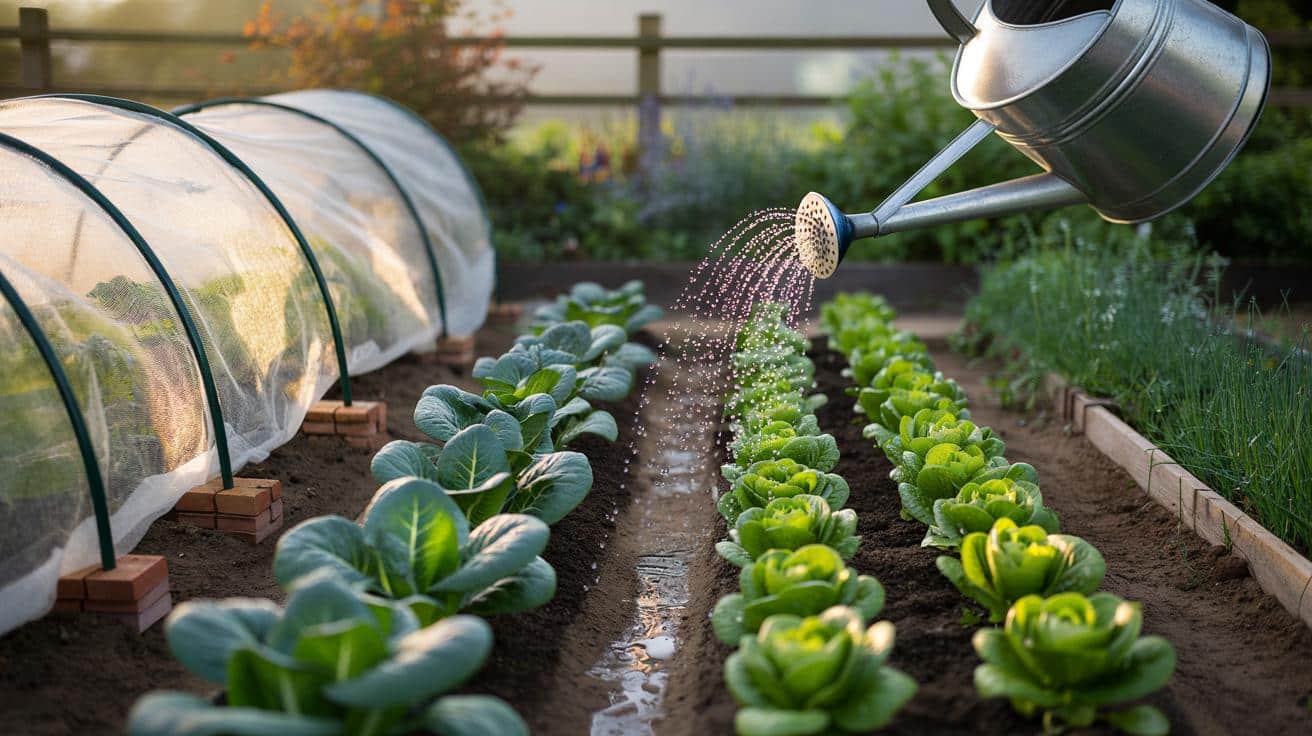Yet winter has room for quiet, leafy surprises.
Across plots from patios to allotments, the season isn’t quite over. With careful timing, spacing and simple cover, late sowings of spinach and lamb’s lettuce can turn bare soil into a steady trickle of salad through winter and into spring.
Late sowing myths that keep good beds idle
Garden centre chatter often says it’s too late after mid-October. The days shorten, temperatures drop and growth slows. That doesn’t equal a dead stop. Soil still holds some warmth, especially where beds drain well and catch midday sun. Seedlings that establish before the first hard cold will sit tight, then push on again as light returns in late February.
The workable window sits around 15–20 October for most lowland gardens. Act within it and seedlings settle before deep cold.
What changes after mid-october
Light drops below the rapid-growth threshold, so plants take longer to size up. The aim shifts from speed to survival and steady development. You bank living roots in the ground, hold them safe with light protection, and harvest small, frequent cuts rather than big bunches.
Timing that still works in britain’s short days
Dates that still pay off
Sow spinach and lamb’s lettuce between 15 and 20 October in much of England and milder coasts. In colder northern or high-altitude spots, bring that forward by a week. Later sowings won’t race, but they still give spring pickings once daylength rises.
Spacing that pays for itself
Set rows 25–30 cm apart for spinach and 20–25 cm for lamb’s lettuce. This invites light to the base and lets air move, which curbs mildew and other fungal trouble. Scatter seed thinly in shallow drills 1 cm deep, then firm gently with the back of a rake so seed contacts moist soil. Clean out weeds before you start to remove competition in short days.
- Work a fine tilth and avoid clods that trap seed too deep.
- After sowing, label rows and leave a narrow path so you can harvest without trampling saturated soil.
- Thin early once seedlings show true leaves; crowding slows growth and invites disease.
Water like a pro without drowning seedlings
Give a thorough drink straight after sowing: roughly 1 litre per linear metre of row with a fine rose. Then switch to light, regular morning waterings when the surface dries. Morning watering leaves foliage dry by night, which reduces disease. In a wet spell, skip irrigation altogether and keep an eye on drainage.
Too much water breeds damping-off; too little blocks germination. Aim for moist, not wet, with a steady wet–dry rhythm.
In rainy regions, a 3–5 cm raised bed sheds excess water and warms faster. In dry, windy spots, lay a light mulch of shredded leaves or straw around, not over, the seed line to limit splash and temperature swings. Keep crowns clear.
Cover smart: fleece, frames and quick airing
Horticultural fleece over hoops adds a couple of degrees, blunts icy winds and speeds recovery after cold snaps. It also keeps birds off and slows slug raids. Secure edges with bricks or pegs so gusts can’t lift it. Check after storms to keep it tight.
Vent whenever daytime temperatures rise above 10°C to release humidity and prevent disease build-up under the cover.
When to remove or lift covers
Lift fleece after heavy rain to dry foliage, then replace before nightfall if frost threatens. On mild days, leave one end open so plants harden slowly. In very cold spells, a second layer over hoops creates a simple low tunnel that holds heat a little longer at dusk.
What late sowings still deliver
Spinach sown in the third week of October can give baby leaves by December in milder districts, or early January further north. Lamb’s lettuce forms tidy rosettes that shrug off frost and hold texture. Cold nudges spinach towards a sweeter, cleaner flavour, while lamb’s lettuce keeps its gentle, nutty bite.
Harvest little and often. For spinach, snip outer leaves and let hearts keep growing. For lamb’s lettuce, cut whole rosettes with a knife and leave some plants to refill. With good spacing and cover, expect intermittent pickings across 90–120 days, then a surge as light strengthens in late winter.
| Crop | Last practical sowing | Row spacing | Min soil temp | First likely pick | Protection |
|---|---|---|---|---|---|
| Spinach | 15–20 October | 25–30 cm | 5–7°C | December–January | Fleece or low tunnel |
| Lamb’s lettuce | to late October | 20–25 cm | 4–6°C | January–February | Fleece |
The three moves that change a dull bed into a winter salad bar
- Beat the clock: sow by the third week of October to root seedlings before harsh cold.
- Give space and air: keep rows wide and thin early to limit mildew and speed leaf size.
- Guard the top growth: water in the morning, cover with fleece, then vent above 10°C.
Risks, workarounds and a quick cost–benefit check
Slugs rise in mild, wet spells. Set beer traps, remove hiding spots and hand-pick at dusk. Birds pull seedlings; fleece stops the tugging. Fungal scares spike under stale, damp air; vent on bright days and avoid soaking evening waterings.
Costs stay modest. One packet of lamb’s lettuce seed sows 8–10 rows. A 10 m² bed under fleece can supply several family salads each week in late winter if you rotate harvests across rows. Compare that to shop prices for winter leaves and the value stacks up quickly.
Regional reality and simple adjustments
In southern and coastal zones, push sowing to 20 October. In upland and northern gardens, sow a week earlier or raise plants in modules under cover and transplant sturdy clumps during a mild spell. Urban walls and fences store heat and screen wind; use those microclimates for your late rows.
If soil sits cold and wet, switch to a raised planter with a free-draining mix. A basic cold frame or a clear storage box propped on bricks works as a mini cloche. Aim for direct sun between 10:00 and 14:00 to keep growth ticking during short days.
Extra ideas that widen your winter plate
Thread garlic or spring onion sets between spinach rows to fill the 25–30 cm alleys without shading. Add a fast row of mustard greens as an insurance crop; cut small leaves at 25–35 days for peppery mixes. Use spent fleece to shield salads from bird mess and hail during erratic winter showers.
As spring breaks, let one spinach row flower for early pollinators, then compost it. Follow cleared space with early beetroot or a second wave of mixed salads. That late-October push keeps beds earning through winter and sets you up for a smooth handover into the first spring harvests.








